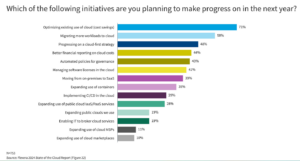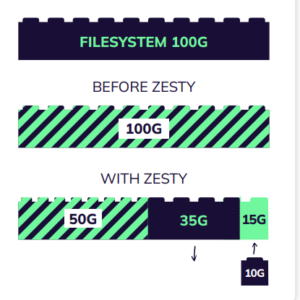
Reining in Cloud Wastage By Stopping Over-Provisioning

(TAW4/Shutterstock)
Companies will waste $135 billion worth of cloud resources in 2024, or about 30% of the worldwide public cloud spending of $675 billion, according to Gartner. That’s the bad news. The good news is that an array of FinOps service providers are lining up to help customers reclaim those cloud dollars.
In the early days of the public cloud, cost savings and agility were the big drivers. The idea was that companies would move their data and applications to the cloud to get out of the business of buying and managing infrastructure, which reduced their overall IT spending and freed them to focus on their core business.
Over the years, the public cloud mantra has morphed a bit, and today’s cloud pillars are speed and convenience. The public cloud is wonderful for startups and fast-growing companies that don’t want to commit large sums to compute and storage infrastructure that they may or may not need. They are willing to pay a premium for the capability to rapidly scale their needs on-demand.
However, today’s public cloud is not as great for companies that are larger or slowly growing. Companies that are paying on-demand prices but aren’t taking advantage of on-demand scalability are overpaying, while companies that miscalculated how much compute and storage they would need are finding that the public cloud is not nearly as elastic as they were led to believe. That’s particularly true when it comes to storage.
Customers’ cloud bills have increased dramatically in recent years. A recent Flexera report discovered a 21% increase year over year in organizations that are spending $1 million or more per month on cloud.
In its recent Budget Planning Guide for 2025, Forrester advised technology executives to “ruthlessly automate manual tasks” to reduce cloud sprawl.

Cost savings in the cloud is the top priority this year, according to Flexera’s 2024 State of the Cloud Report
“Stop independent cloud spending by establishing a clear FinOps practice,” the analyst group wrote. “This includes setting up a centralized team responsible for managing cloud costs and optimizing resource usage. Next, implement a cloud cost waste, and make data-driven decisions to optimize costs. These tools can help automate the process of identifying unused resources, right-sizing instances, and enforcing cost governance policies.
One of the FinOps vendors helping customers to stay on top of their cloud storage and compute spending is Zesty. Omer Hamerman, Principal Engineer at Zesty, says Zesty Disk allows customers to shrink and expand their AWS EBS storage on the fly based on usage, and cut up to 60% of their storage costs.
“The first question I ask customers [is] how do you decide how much storage you need to provision for a typical application?” he tells Datanami. “And nobody knows the answer.”
If a customer thinks they’ll need 10GB of block storage for their machine learning application, for example, they can provision a single block of 10GB from AWS and use it. If they need more storage, they can simply provision additional capacity as they go. But if it turns out they need less storage, that’s where things get interesting.
Zesty’s trick is to break that initial 10GB order up into multiple blocks, such as one 5GB block, two 2GB blocks, and one 1GB block, and spread the customers’ data across all of them. If Zesty’s monitoring detects that the customer application only needs 3GB, they can turn off the 5GB and 1GB blocks, and move the data under the covers to the two 2GB blocks, for 4GB total. Zesty Disk does this automatically through API connections to AWS, and there’s no interruption to the flow of data or the application, Hamerman says.
“We allow you to still keep your block storage with your performance and everything that comes with having block storage attached, but still gain elasticity,” he says. “We’re like a DevOps engineer you install on your server.”
This problem is fairly common among newer applications built atop modern databases, where customers don’t want to ever delete data, and with machine learning and AI applications, which can have unpredictable data storage needs, he says. Well established applications, such as CRM or ERP systems, are less likely to have this problem.
“That’s just the nature of applications. They grow over time. Some of them very quickly, some of them quite slow,” Hamerman says. “How do you forecast these things? People actually can’t. It’s really hard to focus on forecasts.”
Zesty, which is a member of the FinOps Foundation, also offers Commitment Manager, which helps customers manage their EC2 and compute spending on AWS. The offering works by automatically moving workloads to the optimal combination of AWS Reserved Instance and Savings Plan instances, which come with one- and three-year commitments.
If Zesty detects the customer isn’t making good use of RI, for example, it will shift workload to another plan, or the Convertible Reserved Instances (CRIs). “Everything that you can reserve for either a year or three years, we can help you take care of the reservations,” Hamerman says. The company is working to roll out a solution for AWS Spot instances, he says.
Another FinOps customer to keep on your radar is nOps. The San Francisco company says it provides “complete visibility” into customers’ AWS costs, including reserved instances and the AWS Spot market.
“With awareness of all your AWS commitments and the AWS Spot market, nOps automatically fulfills your commitments and provisions additional compute to Spot,” the company says.
nOps, which also is a FinOps Foundation member, says it has saved its customers more than $1.5 billion in AWS spending, and grown its customer base by 450% over the past 18 months.
The rise of generative AI has brought cloud compute optimization to a tipping point, says nOps CEO and Founder JT Giri.
“While various point solutions address specific cloud optimization needs, engineering teams do not have the time to manually manage and optimize the ever-growing complexity of cloud resources,” he says in a press release. “Instead, they need one solution that provides complete visibility into cloud spend, to automatic optimization and single-click cloud waste clean up so they can focus on innovation to drive company growth. This is why we founded nOps and why we have been so successful.
Related Items:
Flexera 2024 State of the Cloud Reveals Spending as the Top Challenge of Cloud Computing
The Cloud Is Great for Data, Except for Those Super High Costs




























